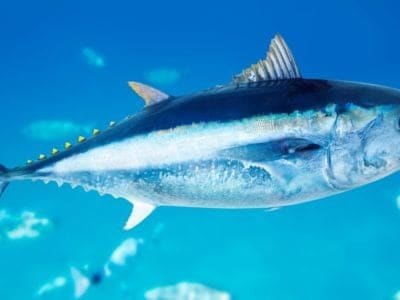Mola mola (Ocean Sunfish)
Mola mola
The ocean sunfish is the biggest bony fish in the world
Advertisement
Mola mola (Ocean Sunfish) Scientific Classification
- Kingdom
- Animalia
- Phylum
- Chordata
- Class
- Actinopterygii
- Order
- Tetraodontiformes
- Family
- Molidae
- Genus
- Mola
- Scientific Name
- Mola mola
Read our Complete Guide to Classification of Animals.
Mola mola (Ocean Sunfish) Conservation Status
Mola mola (Ocean Sunfish) Facts
- Prey
- Crustaceans, jellyfish, squid, sponges, and fish
- Group Behavior
- Solitary
- Fun Fact
- The ocean sunfish is the biggest bony fish in the world
- Estimated Population Size
- Unknown
- Biggest Threat
- Overfishing
- Most Distinctive Feature
- The oval-shaped body
- Other Name(s)
- Common mola
- Gestation Period
- Unknown
- Predators
- Sharks, orcas, sea lions, and other fish
- Diet
- Carnivore
- Type
- Ray-finned fish
- Common Name
- Ocean sunfish
- Number Of Species
- 1
- Location
- Worldwide
View all of the Mola mola (Ocean Sunfish) images!
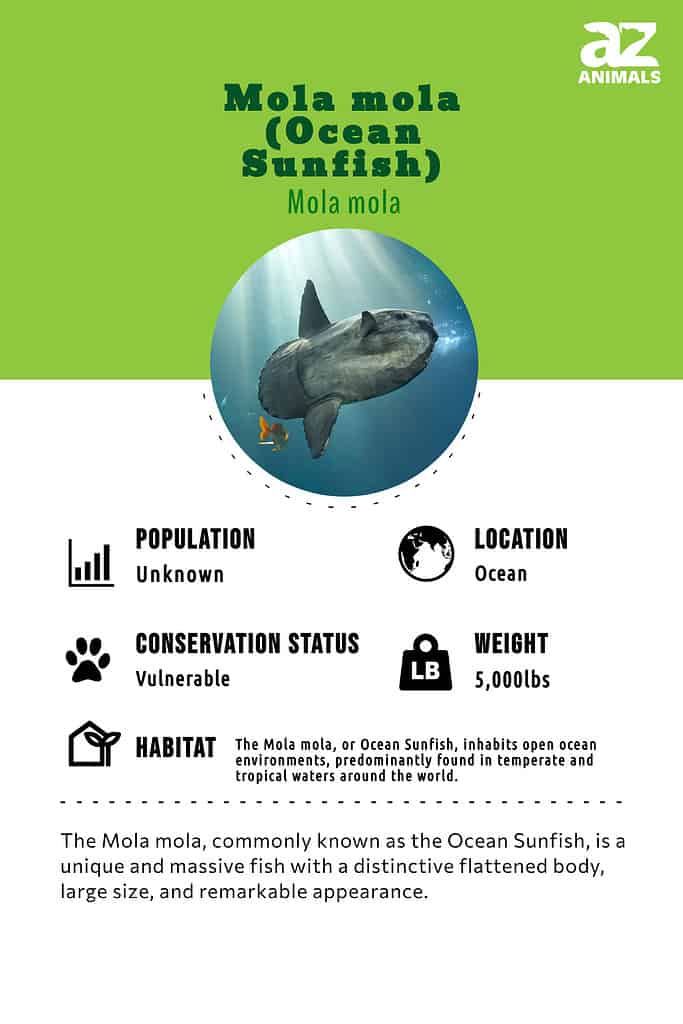
The ocean sunfish (Mola mola) is perhaps the biggest bony fish in the world.
These massive giants travel the world’s oceans in search of food to eat. Despite their size, they are considered to be fairly docile and gentle around human divers.
Almost all recorded injuries have been the result of accidents. This article will cover some interesting facts about the habitat, diet, and adaptations of the Ocean Sunfish.
3 Incredible Ocean Sunfish Facts!
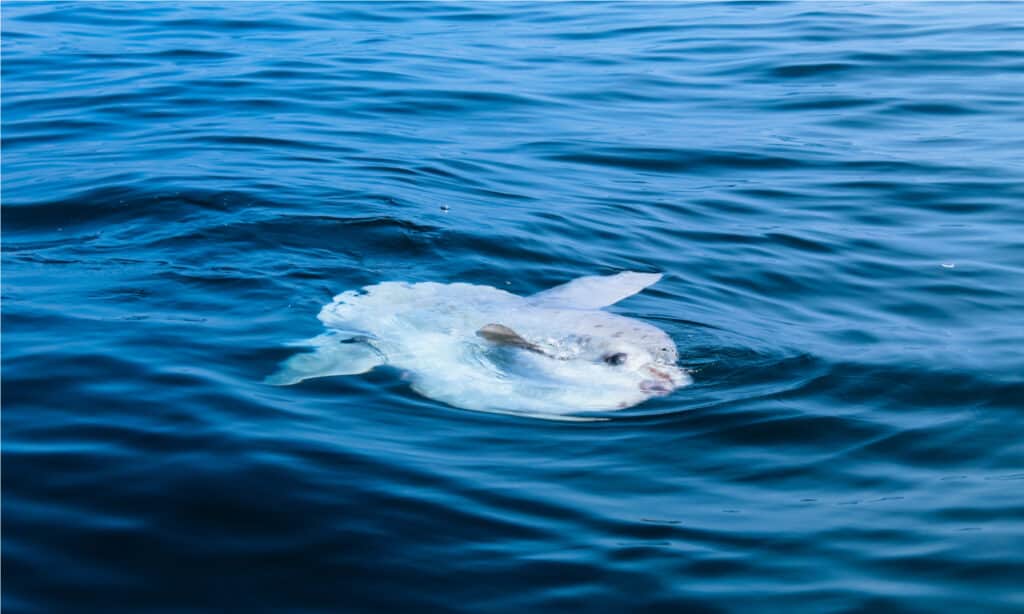
One of the sunfish’s crucial adaptations is the presence of a unique mucus lining in its stomach, which serves as a protective measure, preventing the fish from being stung by its prey even after it has been swallowed.
©Anna K Mueller/Shutterstock.com
- The ocean sunfish is a relatively slow and cumbersome swimmer that lacks the gas-filled swim bladder that gives other fish their buoyancy. Some sunfish have been tracked moving about 16 miles a day, traveling wherever the currents take them.
- A special mucus lining in the stomach is among its most critical adaptations. This helps the sunfish avoid being stung by their prey after swallowing it.
- The body of the sunfish is a bastion for many different parasites. More than 40 different species have been recorded living on the fish’s skin, including some barnacles. They rely on other types of fish to clean off the parasites from their skin.
Classification and Scientific Name

A world-record saltwater sunfish was recently discovered near the Azores.
©Rui Manuel Teles Gomes/Shutterstock.com
The scientific name of the ocean sunfish is Mola mola. This is the Latin word meaning millstone, which refers to the round shape and rough skin of the sunfish. The species is closely related to the southern sunfish and the hoodwinker sunfish within the same genus. They also belong to the class of bony ray-finned fish.
Evolution and Origins
Ocean sunfish are naturally distributed in the temperate and tropical waters of every ocean worldwide, showcasing their adaptability across different regions. While Mola genotypes exhibit significant variations between the Atlantic and Pacific, the genetic distinctions between individuals in the Northern and Southern hemispheres are relatively minimal.
Since their initial emergence, sunfish have expanded their presence to encompass every tropical and temperate ocean, despite the Molidae family’s seemingly primitive characteristics, they are relatively recent additions to the world of fish.
The existence of fish dates back over 500 million years, with the significant diversification leading to the majority of modern fish occurring around 100 million years ago.
Appearance
If the sunfish is known for anything, it’s a unique appearance. The body is huge and oval-shaped, but also relatively flat from side to side. Instead of scales, they have thick rubbery skin with uneven patches of tubercles, meaning small nodules that stick out from the surface. Other important features include small mouths and large eyes on their massive heads.
Although they have huge dorsal and anal fins that extend far from the body, the tail fin has been reduced to a strange-looking lumpy structure on the back; it is used as a kind of rudder to steer through the water. Measuring up to 10 feet long from head to tail and nearly 5,000 pounds, the ocean sunfish is perhaps the largest bony fish in the world (meaning most types of fish besides the class of sharks and rays).
Distribution, Population, and Habitat
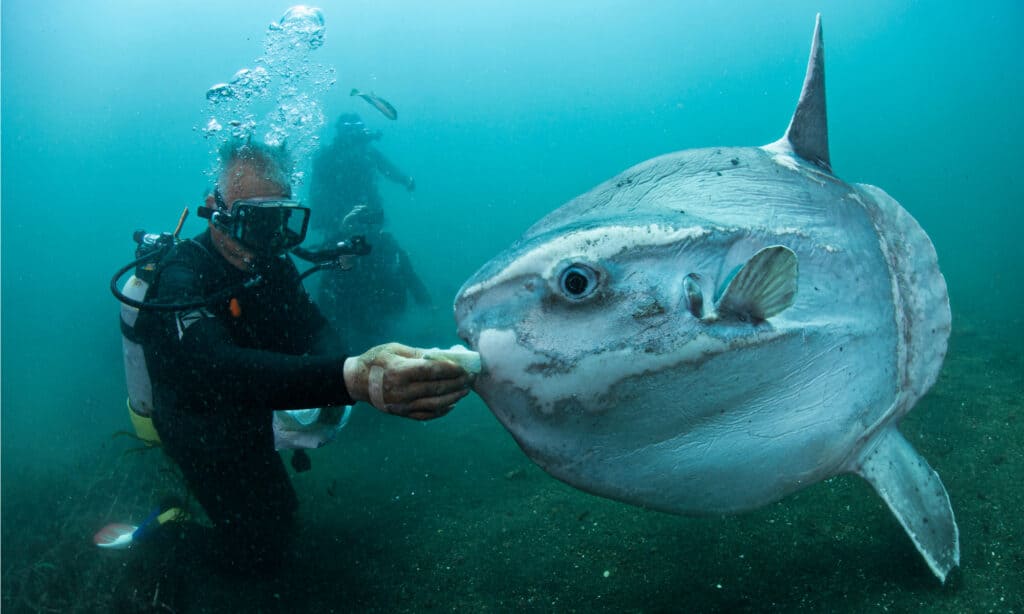
©Martin Voeller/Shutterstock.com
The ocean sunfish can be found in temperate and tropical waters all around the planet.
They prefer to inhabit open oceans relatively close to the surface, but they will also return to kelp beds and coral reefs occasionally where they can be cleaned by smaller fish because their skin accumulates so many parasites. According to the IUCN Red List, ocean sunfish are vulnerable to extinction.
Overfishing has contributed to their decline, but they’re often accidentally caught up in gillnets that cut into their skin. Sunfish will also consume plastic bags, mistaking them for a potential meal. The bag can clog the stomach and slowly starve it.
Predators and Prey
The ocean sunfish is primarily a carnivorous fish. Their annual migration in the spring and summer appears to follow the course of their prey. They also travel every day from shallow to deeper water in response to the presence of prey.
What eats the ocean sunfish?
On account of its giant size, an adult ocean sunfish has few natural predators in the world except perhaps for sea lions, killer whales, and large sharks. Juveniles may be vulnerable to tuna and other large fish.
What does the ocean sunfish eat?
Jellyfish, soft-bodied crustaceans, small fish, sponges, and squid are thought to make up the bulk of their diet. Their mouths are filled with two pairs of hard teeth plates in the shape of a bird’s beak. These adaptations enable them to suck up gelatinous animals into its mouth without chewing very much.
Reproduction and Lifespan
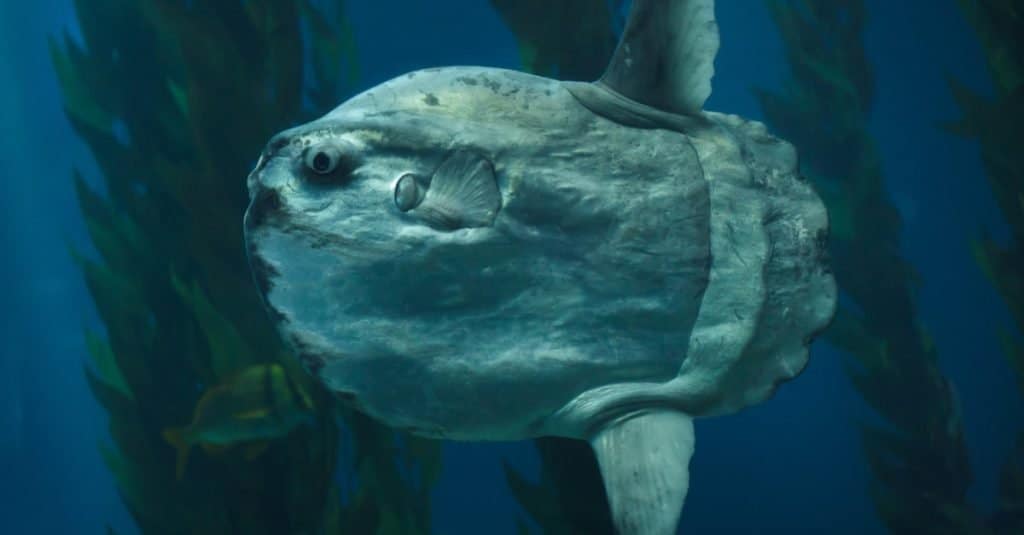
The ocean sunfish inhabits both temperate and tropical waters across the entire globe.
©Vladimir Wrangel/Shutterstock.com
Unfortunately, because enough research hasn’t been conducted, we don’t know many facts about the mating strategies and reproductive behavior of ocean sunfish. In some areas of the world, they are thought to mate in the summer months. Females can produce over 300 million eggs in the breeding season, which makes them one of the most fertile species of vertebrates in the world. The parent is thought to provide minimal care for the eggs.
After hatching, the ocean sunfish goes through two different larval stages. In the first stage, the baby sunfish resembles small round pufferfish with well-developed fins and spines (this testifies to its evolutionary ancestry because the sunfish and pufferfish are somewhat closely related). In the second stage, the tails and spines of the baby sunfish are absorbed back into the body or disappear completely. As a baby or juvenile, the sunfish can grow some 2 pounds per day. Upon reaching adulthood, they will have grown some 60 million times from their initial egg phase. The lifespan in the wild has never been determined, but they have been known to live more than 10 years in captivity.
Fishing and Cooking
The ocean sunfish (Mola mola) is considered to be something of a delicacy in Asia. It is caught for use as both food and medicine, but the European Union has made this illegal. The meat is said to taste something like a lobster. Because of their demanding care, the sunfish is held by only a few aquariums around the world, including the Monterey Bay Aquarium in California and the Kaiyukan Aquarium in Osaka.
View all 164 animals that start with MMola mola (Ocean Sunfish) FAQs (Frequently Asked Questions)
Where do ocean sunfish live?
Ocean sunfish live in warm water all over the globe. They can be found either close to the coast or out in the deeper ocean, but they prefer to remain close to the surface of the water.
Are sunfish endangered?
No, but they are considered to be a vulnerable species.
How many sunfish are left in the world?
The population numbers have not been properly estimated, but they appear to be in decline.
What do sunfish eat?
Their diet consists of a combination of jellyfish, crustaceans, squid, sponges, and smaller fish.
Why is it called an ocean sunfish?
The English name ocean sunfish comes from its habit of sunbathing near the surface of the water.
How big are ocean sunfish?
The ocean sunfish has an average length of 5 feet from head to tail, but they have been known to reach up to 10 feet long. Their height from the tip of one fin to another also reaches up to 14 feet.
What does an ocean sunfish look like?
They are giant, oval-shaped fish with two triangular fins extending from the back and the pelvis, while the lumpy tail fin runs vertically along the length of the body. Their brown, gray, or silvery skin is covered in many rough nodules.
Thank you for reading! Have some feedback for us? Contact the AZ Animals editorial team.
Sources
- Animal Diversity Web / Accessed April 18, 2022
- Monterey Bay Aquarium / Accessed April 18, 2022















